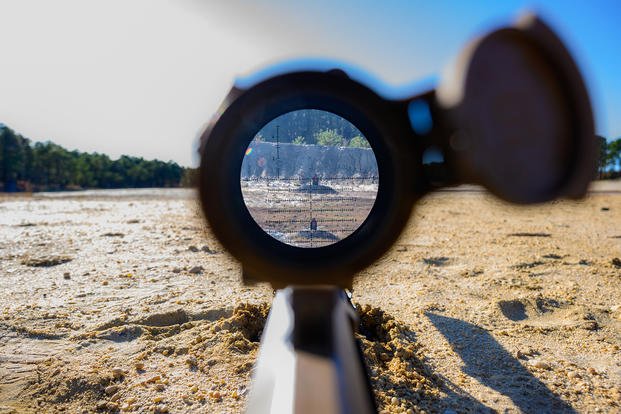The U.S. military is looking to equip special operations forces with their longest-range sniper rifle ever fielded in an effort to maintain superiority against Russian and Chinese snipers in a future potential conflict.
According to a new notice published on Dec. 19, 2023, U.S. Special Operations Command is conducting market research for a so-called "Extreme Long Range-Sniper Rifle" (ELR-SR) capable of delivering precise fire at a range of up to 2,500 meters (2,730 yards), or just over a mile-and-a-half.
A modular sniper system capable of using multiple calibers of bullets, the ELR-SR would replace two guns in the U.S. armory: the widely used Barrett M107 .50 caliber sniper rifle, which has an effective range of 2,000 meters (or 2,187 yards), and the Mk 15 sniper rifle that is used primarily by Navy SEALs and has an effective range of 1,800 meters (or 1,970 yards), according to the notice.
For context, the long-standing record for longest-distance sniper shot was achieved by legendary Marine Corps Scout Sniper Carlos Hathcock in Vietnam in 1967 and was at 2,286 meters (or 2,500 yards), albeit set with an M2 .50 caliber machine gun rather than a conventional sniper rifle.
That record remained unbroken until 2002, when Canadian Army sniper Master Cpl. Arron Perry achieved a confirmed kill at 2,310 meters (or 2,526 yards) with a C15, which is the Canadian military's version of the TAC-50 that counts the Mk 15 as a descendant. Another Canadian Army sniper, Cpl. Rob Furlong, would break that record days later, also with a C15, with a confirmed kill at 2,430 meters, or 2,657 yards.
The current record for longest-distance kill is purportedly held by Ukrainian military sniper Vyacheslav Kovalsky, who reportedly took out a Russian soldier from a distance of 3,800 meters (or 4,156 yards) with a "Horizon's Lord" sniper rifle in 2023 during the Russian invasion of Ukraine, though The Wall Street Journal reported that Kovalsky's claim remains disputed by some tested marksmen and ballistics experts.
While praising existing sniper rifles in the U.S. inventory, U.S. Special Operations Command spokesperson Navy Lt. Cassandra Thompson told Military.com in an email that the intent is to keep up with "advancements developed by industry partners as well as the long-range shooting sports community."
The ostensible mission for this new long-range sniper rifle? To "increase effective range and probability of hit in support of the great power competition for Special Operations Forces in near peer conflicts," according to Thompson, invoking the Defense Department's preferred euphemisms for notional future conflicts with Russia and China.
As the U.S. struggles to reorient itself from fighting violent extremist organizations in the Middle East toward "great power" or "near peer" competitors like Russia or China, the Pentagon has invested significant effort in overhauling its sniper capabilities, with the Army and Marine Corps fielding both new designated marksman rifles (the M110A1 Squad Designated Marksman Rifle and M38 variant of the M27 Infantry Automatic Rifle, respectively) and new sniper rifles (the M110A1 Compact Semi-Automatic Sniper System and the Mk 13 Mod 7, respectively) in recent years.
The U.S. military has been worried about a sniper gap with Russia, in particular, for the better part of a decade: A 2016 Army report on the evolution of Russian tactics following the 2014 annexation of Crimea found that Russian snipers have become "far more advanced than the precision shooters U.S. formations have encountered over the last 15 years" during the U.S. military campaigns in Iraq and Afghanistan, primarily because Russian sniper teams have access to "sophisticated weapons comparable to rifles in the U.S. inventory."
In response to the increased threat posed by Russian sharpshooters, the Army accelerated the deployment of qualified soldiers in designated marksman roles equipped with rifles designed for longer-range engagements, according to the report, culminating with the fielding of the M110A1 SDMR to its first unit in 2020.
Today, the Army, Marine Corps and SOCOM are all in the process of adopting the modular multi-caliber Barrett Multi-Role Adaptive Design (MRAD) sniper rifle which -- chambered in 7.62×51 mm NATO, .300 Norma Magnum and .338 Norma Magnum rounds -- can reach targets at up to 1,500 meters (or 1,600 yards) and will eventually replace the majority of the existing sniper systems in the respective services' arsenals in the coming years.
While the ELR-SR's planned range of 2,500 meters doesn't suggest that U.S. special operations forces will break records on each shot, it will potentially allow snipers to reach the enemy more consistently at distances previously beyond existing sniper systems.
The intent is to also shrink the size of the rifles that operators would need to carry. With an overall length of 56 inches and a weight of no more than 22 pounds unloaded, the ESL-SR is smaller than the M107, according to technical specs listed by the Army.
It's unclear which company may end up producing the ELR-SR for SOCOM, but it's worth noting that in December, Barrett unveiled a new long-range sniper rifle, the MRAD-Extreme Long Range (MRAD-ELR), that would meet many of the required specs.
The Dec. 19 notice for a new rifle comes on the heels of a major shakeup of the U.S. military's sniper community: The Marine Corps' last class of elite Scout Snipers graduated just days earlier amid a large redesign of the service's combat force.












